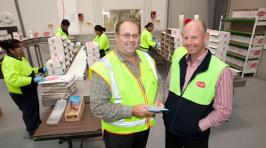New Product Development

EasiYo headquarters.
The New Product Development (NPD) team is comprised of two people – nutrition specialists and/or food technologists – who work with the Compliance, Finance and Marketing teams to develop a new product. Sales and Marketing is involved up front – researching, briefing and finding information to support the NPD team. During development, the Compliance team ensures the product will comply with all EasiYo internal requirements and those of external stakeholders – including New Zealand Food Safety Authority and Ministry of Agriculture and Forestry (now part of the Ministry for Primary Industries) regulations. The Finance team keeps an eye on costing and discusses whether the product is viable on economic grounds.
NPD often starts with a brainstorming session based on market research by the marketing team, commissioned research reports on New Zealand and international competitors' product development, and food, flavour and health trends. The current trend for indulgence foods, combined with consumers' awareness of and desire for healthy food choices, has informed some of EasiYo's developments, such as the 'and bits' range.
In coming up with new ideas, the company also has to consider the practicalities of marketing: Will it be a 'niche' product? If so, how many people will buy it? For this reason, Marketing Manager Zahra Woodroffe explains, EasiYo products tend to be more 'main-stream'. The more flavours you add to one product, the more polarising it becomes. And, of course, a major constraint is that all the ingredients must be dried.
Ideally, NPD follows a timetable which allows a three-month lead time. This sequence, however, isn't always possible, so flexibility is built into the NPD programme. Sometimes a concept might seem quite straightforward at the planning stage, but developing it proves harder than envisaged and more time is required. A concept which everyone agrees is good might be put on hold and picked up months or even years later. The yoghurt 'and bits' line is one such example. First proposed and trialled some years ago, the yoghurt didn't get any further than the trialling stage because the production plant didn't have the capability to process the ingredients. In each trial the bits, though cut very small, became stuck in the machine. It wasn't until 2010, when workers in the production plant adapted the machine to allow for inclusions, that the 'and bits' yoghurt was produced.
Trialling a new product involves lots of testing, and creating a new flavour combination is more than just adding the desired flavours. Some flavours, such as citrus, don't have the same taste when added to particular food combinations. The NPD team first needs to test different substances to find one that gives the taste they want. Having identified the ingredients, they then need to test combinations and amounts of ingredients. During development of the 'and bits' range, there is a lot of testing for inclusions, as some freeze-dried fruit works well with yoghurt, while others don't.

EasiYo headquarters.
A lot of the taste-testing is done 'in house', rather than in formal sensory tests. With multiple cultures represented on the staff, as well as individual taste preferences, this has proved a good way of rating new products – and those which rated well with the staff have been the ones that have sold well. The team uses some outsiders to test the product before development is completed and also gets feedback from customers as well as children in the schools that EasiYo supports.
Testing doesn't stop once a new product is developed – it is built in to the bulk manufacturing process. Each stage in handling the pre-packaged food – mixing the milk powder and other ingredients, weighing the mix and filling the sachets – is done in a sterile section of the building known as the critical hygiene area. Environmental testing is conducted in this area and the outer packing areas to monitor hygiene standards and check for the presence of any foreign matter or hazardous microbes. Every day, a sample pack of each food item produced in the plant undergoes microbiological testing. These tests look for any traces of Salmonella, Listeria and coliform bacteria such as E.coli, Bacillus cerus and coagulase-positive Staphylococci.
New Zealand's smaller population, combined with limits on supermarket shelving, means that slower-selling lines are not 'ranged' and therefore some products are not available in New Zealand supermarkets. Zahra says that items such as the dips (1997) and mousses and cheesecakes (2009) didn't meet expected sales so were discontinued.
